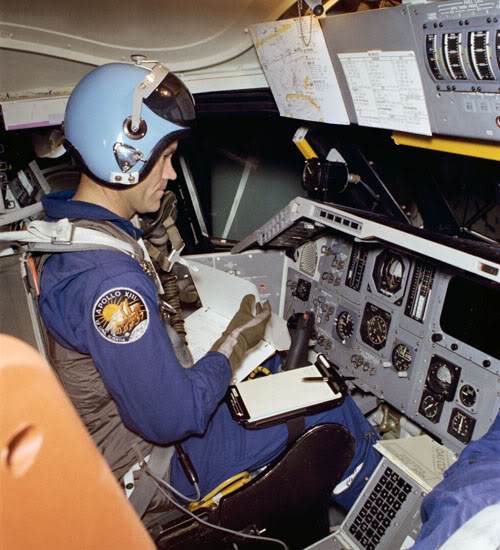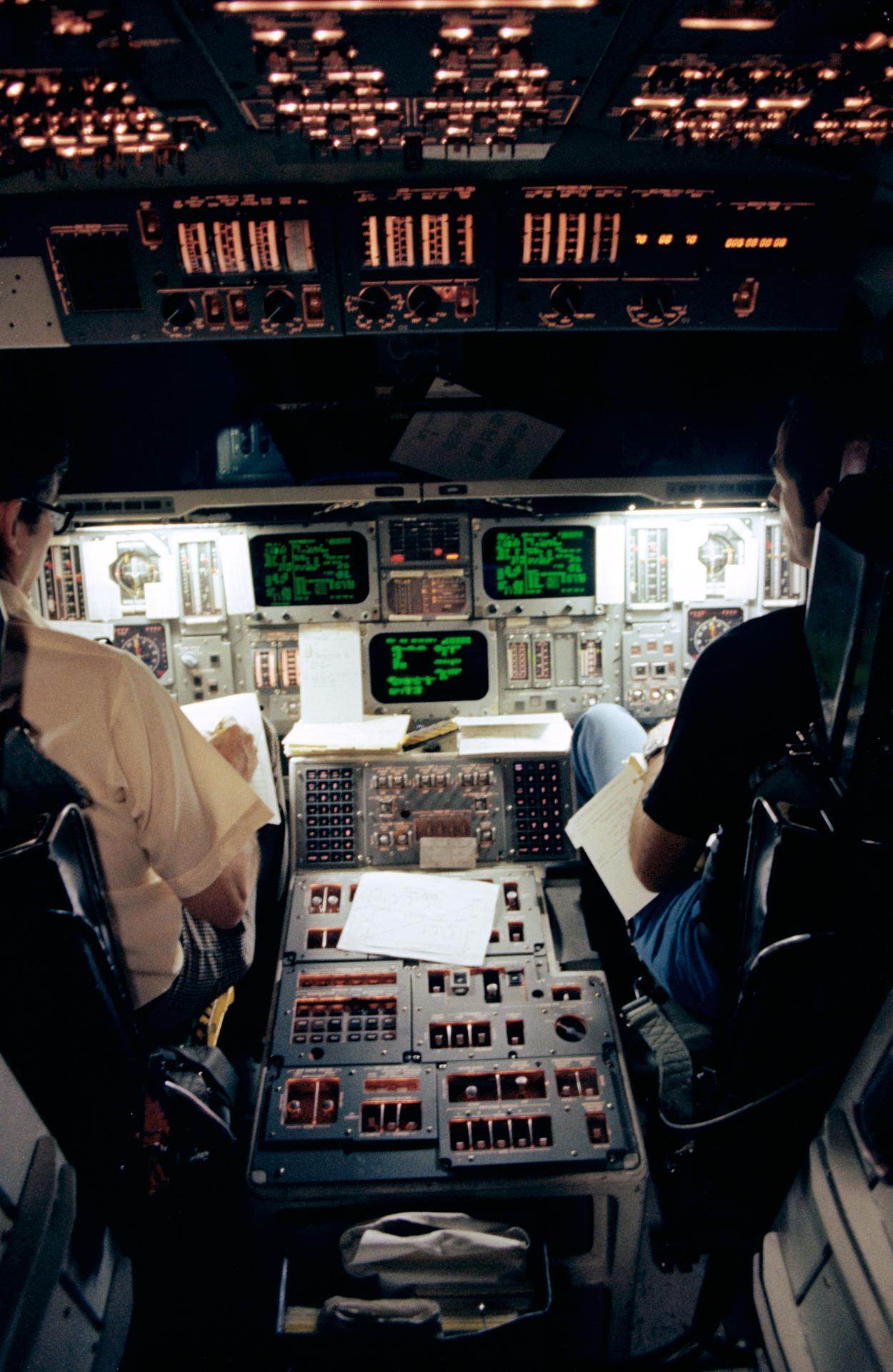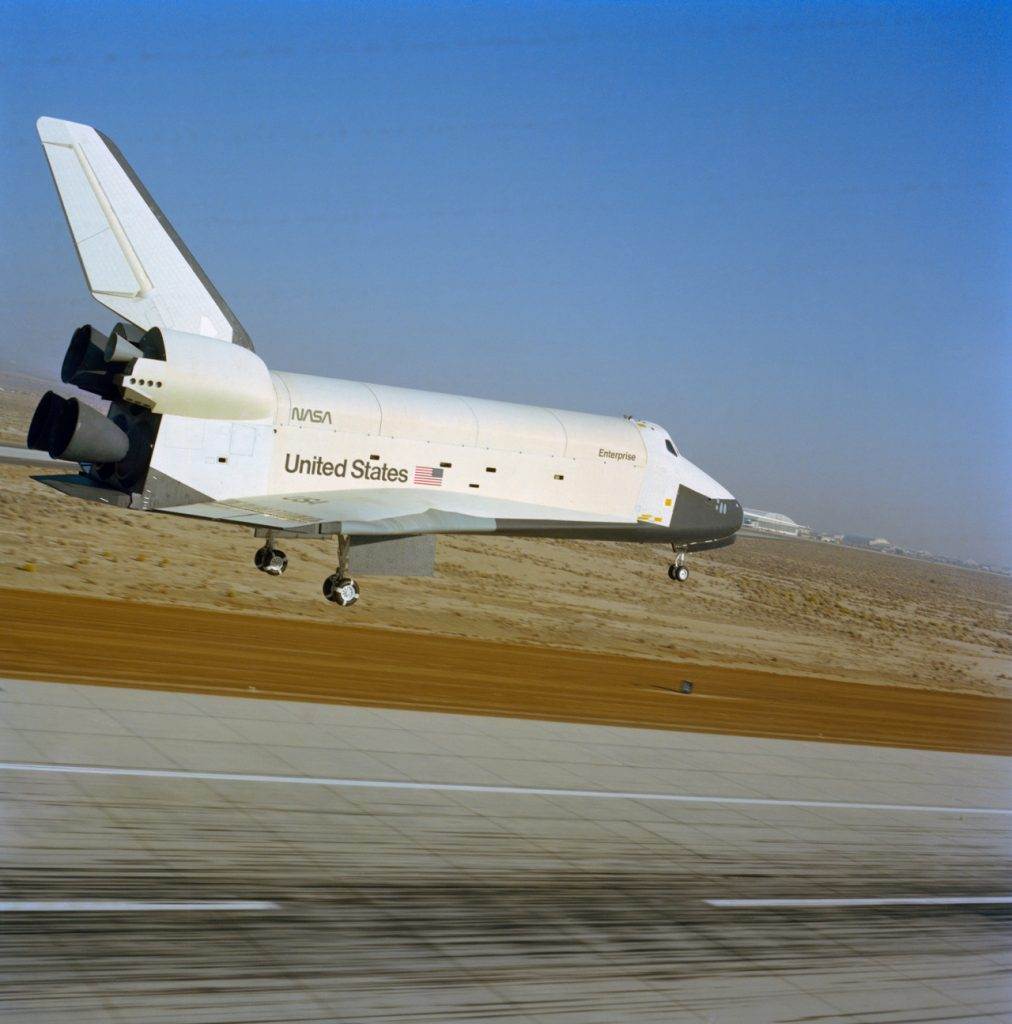This Space Available
By Emily Carney
By the mid-1970s, Space Shuttle development was in full swing, even though the Space Transportation System wouldn’t fly until 1981 (and the delays that plagued the early Shuttle program deserve their own story). One part of the strategy for getting the Shuttle – championed at the time as part airplane, part cargo ship, and part spaceship – off the ground was, of course, to train its flight crew in how to fly this brand-new type of vehicle. The first program that demonstrated the Shuttle’s flight capabilities was 1977’s Approach and Landing Tests, which consisted of five crewed landings that may not have gained its crews flight time, but showed that the Shuttle could land like a heavy glider, unpowered, on a long runway. Astronauts Fred Haise, Gordon Fullerton, Joe Engle, and Richard Truly were to demonstrate Enterprise’s flight fidelity – and hopefully, work out any sneaky issues that beleaguered the Shuttle – within six months. (Spoiler: They, indeed, would find some sneaky issues.)
And, naturally, these crews needed a simulator to help teach them how to fly this new-style spaceship – or, in this case, Earth ship. Enter Johnson Space Center’s Orbiter Aeroflight Simulator (OAS) located within the campus’ Building 5.
There is precious little available on the Internet about the OAS, save for a 2010 history of the Jake Garn Mission Simulator and Training Facility available through the NASA Technical Reports Server and a 2013 oral history by Frank E. Hughes, who served as flight planner for the Approach and Landing Tests. The OAS’ origins can be traced to 1976 when it was built and began to be utilized to support the Approach and Landing Tests. According to Shuttle expert Mark Kirkman, “Built by Link, the OAS was configured like Enterprise to support crew training and atmospheric flight procedures development necessary for the ALT (Approach & Landing Tests) Program.” Some literature has equated the OAS with what it would later become – the Motion Base Shuttle Mission Simulator – which has likely led to its obscurity. The only readily available photo I have of it in OAS mode shows ALT commander Fred Haise training at its controls.

Hughes’ oral history discusses at length the challenges of transitioning from Apollo to the Shuttle era, particularly in the realm of computers. The concept of digital fly-by-wire was relatively new. Much of the Shuttle was controlled by its computers, which were advanced for their time and inspired by Skylab’s double-redundant ATMDC system; the Shuttle system required quadruple redundancy to ensure confidence in its operations. This proved to be a learning curve in providing simulations, according to Hughes:
Hardware-wise, remember before, in Apollo, we had that interpretively-simulated computer system where you had a computer simulator but you put the flight software into it and it behaved like the flight computer things like that. To simulate the Shuttle flight computers, the computers were fast, as fast as the simulator computers we had at the time. Remember, we’re talking about ’74, ’75-6, that kind of timeframe. There was no computer fast enough that had extra capacity and speed to pretend to be the Shuttle computer. That happened later, but by now, you just used real flight computers in the simulator. It meant that we had actually five real flight computers in the simulator in a cabinet and IBM built this, it’s called a SID, it’s a Simulation Interface Device. Its job was to fool those five computers into thinking they were in space. They would do all kinds of things to fake it out. The SID created accelerations and gravity just as it would appear in the real flight. The computers measured gravity, and it would be one G on the pad, go to zero in orbit or it would be under thrust measuring the launch phase. So the SID would tell all the things the computer needed to know. Give it time signals as though it was coming from external sources, but the computers would talk to each other just like they would in the real system and vote against each other and so on.
Hughes also discussed how the data and experience gleaned from the ALT program led to issues being worked out in time for STS-1, the Space Shuttle’s first orbital flight; in this passage, Hughes referred to the pilot-induced oscillation (PIO) inadvertently made by Haise in the final ALT flight, which was caused by the Shuttle’s fly-by-wire system prioritizing pitch over roll:
Yes, so ’76 and ’77, we took the only simulator we had, the motion base, and put into it all the dynamics that we knew about the airplane, all the systems that we’re flying, but there was no environmental control system. We were just breathing air. They had oxygen because you were going up 35,000 feet, but there was nothing fancy about it. No more than you would get a regular passenger airplane. The five flights, the only one we had any trouble really was, I think it was two, when we came off the airplane; first, third, and fifth was [Fullerton and Haise], and then the second and fourth was [Engle and Truly]. [Author’s note: Hughes references the fifth and last ALT free flight.]
When they came off, they got some turbulence, and so they got into a PIO [Pilot-Induced Oscillation]—that is, that you tend to get into like a porpoising kind of thing. The most important thing that Gordon contributed, Lord love him, (he just passed away this year), said, “Get off the stick.” In other words, just don’t touch it, and it settled out. It just landed. It was just because you start over-controlling it, and everybody had to learn how to handle this thing because it was a control stick that allowed you to change a rate, you were asking for a different rate as opposed to a position. Very different from what airplanes normally do.
Of course, these issues are why space vehicles are extensively tested. While by this point in time the OAS was being modified to simulate space conditions better, Fred Haise detailed on his website how the PIO issue was worked out after October 1977 by performing research and development utilizing aircraft:
Following my…PIO on Free Flight 5 to the Edwards AFB runway, considerable analysis and testing was performed to determine corrections to eliminate Orbiter PIO tendency. Five pilots flew 60 landings in the Dryden Research Center’s F-8 Digital Fly-by-Wire testbed. Eight pilots, including five Space Shuttle Astronauts, flew 16 flights in the Calspan Total In-Flight Simulator, a modified C-131H aircraft. The PIO tendencies noted were a function of control system lag and the pilot cockpit position in the Orbiter being just about at the vehicle center of rotation. This resulted in about a half of a second delay in the pilot’s perception of motion. Software mods were made for the OFT flights to improve those control system tendencies as well as assure in the priority logic that neither pitch nor roll would be locked out. A Heads up Display or HUD was also added to aid the pilot with key parameters displayed in the front window.

After the Approach and Landing Tests ended in October 1977, the OAS was modified to become the Motion Base Simulator (MBS), which was used to train astronauts from January 9, 1979, to the conclusion of the Shuttle program in 2011. The history piece about the Jake Garn Mission Simulator and Training facility stated, “Following the end of the ALT program, both simulators underwent the final preparations to train astronaut crews for the Orbital Flight Test (OFT) missions. For the FBS [Fixed Base Simulator], this included final qualification tests. The MBS, on the other hand, required a change-out of the flight deck controls and displays from the ALT configuration to the OFT configuration.”
The MBS cockpit now resides as a museum piece at the Lone Star Flight Museum in Ellington, Texas, not far from where the Shuttle’s first astronauts trained to learn how to fly the defining space vehicle of the 1980s and beyond.
*****
Top photo: Not a simulator, but a pretty awesome photo: Space Shuttle Enterprise lands at Edwards Air Force Base on October 26, 1977, ending the Approach and Landing Test program. Photo credit: fredhaise.space
This article was previously published on Medium.com.
Emily Carney is a writer, space enthusiast, and creator of the This Space Available space blog, published since 2010. In January 2019, Emily’s This Space Available blog was incorporated into the National Space Society’s blog. The content of Emily’s blog can be accessed via the This Space Available blog category.
Note: The views expressed in This Space Available are those of the author and should not be considered as representing the positions or views of the National Space Society.



















